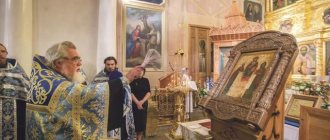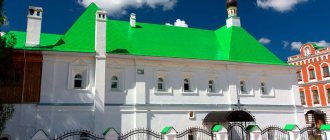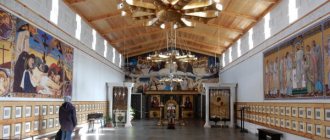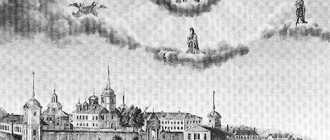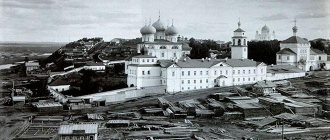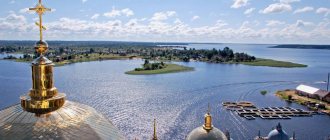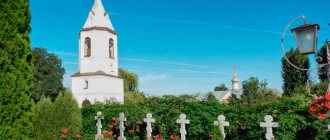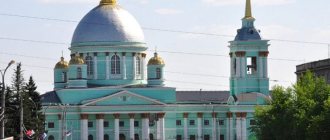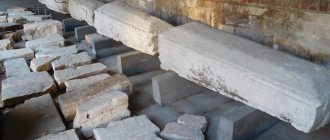Mir
Russia Tyumen Region Tyumen Trinity Tyumen Monastery Map loading in progress...
{"format":"leaflet","minzoom":false,"maxzoom":false,"limit":50,"offset":0,"link":"all","sort":[""], "order":[],"headers":"show","mainlabel":"","intro":"","outro":"","searchlabel":"\u2026 \u0441\u043b\u0435\ u0434\u0443\u044e\u0449\u0438\u0435 \u0440\u0435\u0437\u0443\u043b\u044c\u0442\u0430\u0442\u044b","default":"","import-annotation":false,"width ":"auto","height":"350px","centre":{"text":"","title":"""link":"""lat":57.16986299999999943111106404103338718414306640625,"lon": 65.5128399999999970759745338000357151031494140625,"icon":""},"title":"","label":"","icon":"","lines":[],"polygons":[],"circles":[ ],"rectangles":[],"copycoords":false,"static":false,"zoom":8,"defzoom":14,"layers":["OpenStreetMap"],"image layers":[] ,"overlays":[],"resizable":false,"fullscreen":true,"scrollwheelzoom":true,"cluster":false,"clustermaxzoom":9,"clusterzoomonclick":true,"clustermaxradius":80, "clusterspiderfy":true,"geojson":"","clicktarget":"","showtitle":true,"hidenamespace":false,"template":"","userparam":"","activeicon": "","pagelabel":false,"ajaxcoordproperty":"","ajaxquery":"","locations":[{"text":"\u003Cb\u003E\u003Ca href=\"/palomnik/%D0% A2%D1%80%D0%BE%D0%B8%D1%86%D0%BA%D0%B8%D0%B9_%D0%A2%D1%8E%D0%BC%D0%B5%D0%BD% D1%81%D0%BA%D0%B8%D0%B9_%D0%BC%D1%83%D0%B6%D1%81%D0%BA%D0%BE%D0%B9_%D0%BC%D0% BE%D0%BD%D0%B0%D1%81%D1%82%D1%8B%D1%80%D1%8C\" title=\"\u0422\u0440\u043e\u0438\u0446\u043a\u0438\ u0439 \u0422\u044e\u043c\u0435\u043d\u0441\u043a\u0438\u0439 \u043c\u0443\u0436\u0441\u043a\u043e\u0439 \u043c\u043e\u043d\u 0430\u0441\u0442\u044b\u0440\ u044c\"\u003E\u0422\u0440\u043e\u0438\u0446\u043a\u0438\u0439 \u0422\u044e\u043c\u0435\u043d\u0441\u043a\u0438\u0439 \u043c\ u0443\u0436\u0441\u043a\ u043e\u0439 \u043c\u043e\u043d\u0430\u0441\u0442\u044b\u0440\u044c\u003C/a\u003E\u003C/b\u003E\u003Chr /\u003E\u003Ca href=\"/palomnik/ %D0% A1%D0%B2%D0%BE%D0%B9%D1%81%D1%82%D0%B2%D0%BE:%D0%90%D0%BD%D0%BD%D0%BE%D1%82 %D0%B0%D1%86%D0%B8%D1%8F\" title=\"\u0421\u0432\u043e\u0439\u0441\u0442\u0432\u043e:\u0410\u043d\u043d\u043e\u0442\ u0430\u0446\u0438\u044f\»\u003E\u0410\u043d\u043d\u043e\u0442\u0430\u0446\u0438\u044f\u003C/a\u003E: \u043e\u0434\u0438\u043 d\u0438\u0437\u0441 \u0442\u0430\u0440\u0435\u0439\u0448\u0438\u0445 \u0430\u0440\u0445\u0438\u0442\u0435\u043a\u0442\u0443\u0440\u043d\u044b\u 0445\u0430\u043d\u0441\u0430 \u043c\u0431\u043b\u0435\u0439 \u0421\u0438\u0431\u0438\u0440\u0438, \u0434\u0435\u0439\u0441\u0442\u0432\u0443\u044e\u0449 \u0438\u0439 \u043f\u0440\ u0430\u0432\u043e\u0441\u043b\u0430\u0432\u043d\u044b\u0439 \u043c\u043e\u043d\u0430\u0441\u0442\u044b\u0440\u044c\u0432 \u 0433. \u0422\u044e\u043c\u0435\u043d\u0438. 1616 1616 1616 \u0432\u043b\u0451\u043d \u0432 1995\u0433\u043e\u0434\u0443. \u041f\u0440\u0438 \u043c\u043e\u043d\u0430\u0441\u0442\u044b\u0440\u0435 \u0434\u0435\u0439\u0441\u0442\u0432\u0443\u0435\ u0442\u0422\u044e\u043c\u0435 \u043d\u0441\u043a\u043e\u0435 \u0414\u0443\u0445\u043e\u0432\u043d\u043e\u0435 \u0443\u0447\u0438\u043b\u0438\u0449\u0435. ""title":"\u0422 \u0440\u043e\u0438\u0446\u043a\u0438\u0439 \u0422\u044e\u043c\u0435\u043d\u0441\u043a\u0438\u0439 \u043c\u0443\u0436\u0441\ u043a\u043e\u0439\u043c\u043e \u043d\u0430\u0441\u0442\u044b\u0440\u044c","link":","lat":57.16986299999999943111106404103338718414306640625,"lon":65.512839999999 9970759745338000357151031494140625,"icon":""}],"imageLayers":[] }
57.169863; 65.51284
Russia, Tyumen, Kommunisticheskaya street, 10
Tyumen, Tyumen region 625001
Russia
Telephone:
8(3452) 43-42-21
Email:
Trinity Tyumen Monastery
- one of the oldest architectural ensembles in Siberia, a functioning Orthodox monastery in Tyumen. Founded in 1616, renewed in 1995. The Tyumen Theological School operates at the monastery.
History[edit]
Saint Philotheus, Metropolitan of Tobolsk and All Siberia, Wonderworker
The monastery was founded in 1616 by the monk of the Kazan Raifa desert Nifont. Initially, the monastery did not even have a church. In July 1621, Abraham from Rostov the Great was appointed abbot of the monastery, Jonah Likharev, tonsured from the Kirillo-Belozersky Monastery, was appointed monastery builder, and Elder Onuphry, tonsured from the Novgorod Anthony Monastery, was appointed cellarer. They were tasked with building a monastery church, cutting down new cells and other buildings. In 1622, under the leadership of master Cornelius Khorev, a warm wooden tent church was erected, consecrated as the Transfiguration Church. By a charter from Tsar Mikhail Fedorovich dated January 25 of the same year, the monks were assigned a “ruga” (government salary) and two fishing grounds were assigned to the patrimony.
In 1622, under the governor Prokopiy Khrisanfovich Izmailov, a lot of construction was carried out related to the renovation of the Tyumen fort; the city was almost built again. According to the Watch Book of 1624, in addition to the monastery Church of the Transfiguration, in the city at that time there were:
on the territory of the Kremlin -
- Cathedral Church of the Nativity of the Virgin Mary
- Parish Assumption Church (in the name of St. Nicholas the Wonderworker and Fyodor Stratilates)
on the territory of a fortified settlement (as part of a fort) -
- Church of the Most Merciful Savior (cold)
- Church of the Archangel Michael and St. Mikhail Malein with a chapel in the name of Zosima and Savvaty (warm)
- Church of Elijah the Prophet with the chapel of Boris and Gleb, as well as the chapel of Florus and Laurus
In July 1705, as a result of a large fire, almost the entire city burned down, except for the fort and the first stone Church of the Annunciation. Among other things, the only monastery Church of the Transfiguration of the Savior burned down. Tyumen was not one of the cities where stone construction was planned, but in 1706, Metropolitan Philotheus Leshchinsky petitioned Peter I for permission to build a “small stone church with alms from the worldly people” in the Tyumen Transfiguration Monastery and received it.
The stone cathedral church was erected in 1708-1715, the last 4 years of which were under the direct supervision of F. Leshchinsky, who left the metropolitan see, accepted the schema and lived in the monastery. Finally, on June 3, 1715, the church was consecrated as Trinity, after which the monastery began to be called Trinity. The church became the third stone building in Tyumen after stone barns for the treasury (1702) and the Annunciation Cathedral Church (1704).
Despite the fact that by decree of December 9, 1714, stone construction was prohibited everywhere except St. Petersburg, Metropolitan Philotheus, who returned to the see in 1715, was able to arrange the construction in 1717 on the territory of the monastery of a small two-domed church of Zosima and Savvaty (Forty Martyrs).
The ban on stone construction in Russia was lifted in 1722, and therefore F. Leshchinsky obtained permission to build the Church of the Apostles Peter and Paul. Construction began in 1726, but after the death of the Metropolitan, construction slowed down and lasted until 1755. The construction of the abbot's building and stone walls was carried out just as slowly, in the years 1724-1739.
In 1761, a Latin school was founded at the monastery. On the plan of 1766, Dunkin Garden was marked for the first time. According to the “Ecclesiastical States” dated February 26 (March 8), 1764, the monastery was classified as the lowest, III class. In 1842, there was a severe fire in the city, in which the Peter and Paul Church and the bell tower “were so damaged that nothing remained in them except the stone walls.” The renovations that followed in 1851-1853 made some changes to the appearance of the church. In the “Description of Western Siberia” published in 1862, Ippolit Zavalishin, who was serving a Siberian exile, called the monastery the best in Siberia after the Irkutsk Ascension and Innokentievsky monasteries.
In January 1923, based on the resolution of the People's Commissariat of Justice dated August 24, 1918, the monastery was closed; a little earlier, Bolshaya Monastyrskaya Street was renamed Kommunisticheskaya. In 1922, the provincial archive was located in the house of the abbot of the monastery, which was later transferred to the Spasskaya Church. In December 1929, the monastery was transferred to the jurisdiction of the Gorkomkhoz for use as cultural and public institutions. By the decision of the Tyumen City Committee of the All-Union Communist Party (Bolsheviks) at the beginning of 1930, the grave of Filofei Leshchinsky was destroyed, his remains were transferred to the Tyumen Anti-Religious Museum, located in the Annunciation Cathedral (exploded on the night of June 13-14, 1932). In September 1941, the monastery was transferred to the KECh of the Tyumen garrison.
In 1946, a decision was made to build treatment facilities on the territory of the monastery, for which the Church of the Forty Martyrs (formerly Zosima and Savvaty) and the home church of Metropolitan Philotheus in honor of the Bogolyubskaya Icon of the Mother of God were demolished. The complete destruction of the monastery was prevented by the publication in May 1947 of Resolution of the Council of Ministers of the RSFSR No. 389 “On the protection of architectural monuments,” which also applied to the Trinity Monastery. The protective status of the monastery was increased by Resolution of the Council of Ministers of the USSR dated May 22, 1948 No. 503. In 1949-1950, the Tyumen Regional Executive Committee decided to carry out major repairs. By Resolution of the Council of Ministers of the RSFSR dated August 30, 1960 No. 1327, the monastery was declared an architectural monument of republican significance, and in April of the same year it was transferred to the regional department of culture.
In 1995, for the first time after the closure of the monastery, Archimandrite Tikhon (Bobov) was appointed rector, who has held this position to this day. On December 11, 1996, the transfer of the Trinity Cathedral, the rectory and the building of the parochial (Sunday) school to the use of the Tobolsk and Tyumen diocese began. On the Day of the Holy Trinity, June 15, 2003, the first service was held in the restored Trinity Cathedral. In December 1997, the Tyumen Orthodox Theological School was consecrated, for which a new building was erected in 2006 (architect V. A. Silantiev) opposite the monastery. In the same year, during the renovation of the Ascension-St. George Church, the relics of Philotheus Leshchinsky were discovered, which were solemnly transferred to the Trinity Cathedral.
Schedule of services of the Trinity Monastery in Tyumen
Divine services at the Trinity Monastery in Tyumen are held daily. Also, in addition to traditional services, holiday services dedicated to various religious dates are held here.
Not long ago, in one of the monastery buildings, conversations with parishioners about the Divine Liturgy were resumed, which take place every Sunday morning, immediately after the early Divine Liturgy, at approximately 08:30.
Schedule of services on the official website of the Trinity Monastery of Tyumen
Trinity Cathedral, © Igor Butyrskii
Excursion route
The excursion route to the Holy Trinity Monastery in Tyumen includes a visit to one of the most famous and popular architectural religious complexes throughout Siberia.
It is advisable for tourists to dress according to the weather, comfortably and not provocatively, in accordance with the rules of the Russian Orthodox Church (for women, a skirt and a headscarf are required). You can take with you a container for Holy water and money to buy candles and other goods in the church shop.
Holy Trinity Monastery on Google panoramas of Tyumen
Abbots
- Niphon (1616 - ?) founder
- Sergius (mentioned 1622 [1] - 1655) builder
- Sergius (1655 - 1657) [14]
- Theoktist (1657 - 1663) builder
- Adrian (mentioned January 21, 1669) abbot.
- Anthony (mentioned 1680)
- Gerasim (mentioned 1701)
- Isaac (mentioned 1704)
- Gennady (mentioned 1719 - 1727 [15])
- Daniel
- Demetrius (mentioned 1735) [16]
- Zinovy (1737 - 1743)
- Porfiry (? - no later than 1748 [17])
- ? Mikhail (Mitkevich) (1751 - late 1750s)
- Sophrony (1765 - 1776)
- Theodosius (1777 [18] - 1780)
- Nikodim (Aramilsky) (1786 - 1789 [19])
- Troadius (mentioned June 7, 1791) [20]
- Margaret (mentioned September 9, 1801 [21] - 1808)
- Evgraf (June 4 - December 19, 1814)
- Ambrose (1815 - 1836)
- Vladimir (1836 - 1869)
- Pavel Serebrennikov (1879 - 1880) priest, acting
1811 - 1814 - vacancy
…
- Vitaly (mentioned 1900 [22] - 1902) hierome, acting
- John (Bratolyubov) (September 3, 1917 - 1920) acting
- Irinarch (Sineokov-Andreevsky) (1922) bishop. Tyumen
Since 1995, the abbots of the monastery have been the Tobolsk bishops.
What to see
Today, the ensemble of religious architecture of the Holy Trinity Monastery in Tyumen is limited to two churches. However, such a small number has somehow benefited the monastery: both actual churches welcome visitors with a special atmosphere and can boast of lush decor.
Trinity Cathedral (the same cubic temple) was built in 1715. Its slender snow-white silhouette is crowned with 5 gilded domes, and its appearance combines the severity of the Russian style with the lush decoration of Baroque - a combination that gave rise to the special style of “Ukrainian Baroque”. Restoration is still ongoing inside, but here you can already admire some restored wall frescoes.
Among the cathedral shrines are a cross with a particle of the Life-giving Cross of the Lord, icons of Saints John and Hermogenes of Tobolsk with particles of their relics, and the Jerusalem Icon of the Mother of God.
The Church of Peter and Paul, cruciform in plan, is a cozy church built in 1755 with a characteristic hipped bell tower from pre-Petrine times. Its interiors also cannot boast of lush decoration, but here it is worth paying attention to the neat and solemn two-tiered iconostasis.
Temples
The Trinity Monastery accommodated the main types of churches of that time: traditional cubic (Trinity Cathedral), “refectory” (Church of the Forty Martyrs), cruciform (Peter and Paul Church). A hipped bell tower and a gate bell tower as an addition to them. All three monastery churches were placed diagonally in such a way that when viewed from the city they did not overlap each other and were arranged in a complex composition. In the center of this composition was the most static and massive Trinity Cathedral - the main axis and center of gravity of the entire ensemble. The one-story Church of the Forty Martyrs was moved to the far right corner of the site, enriching the ensemble with its chapters, but at the same time emphasizing the leading role of the other two temples.
The high, almost fortress-like fence with massive pilasters and buttresses on the outer corners is commensurate with the powerful forms of the churches and is closely connected with them.
Before the 1917 revolution, the monastery had 4 stone and 1 wooden churches [3]
Trinity Cathedral
It was erected in 1708 - 1717 (consecrated in 1715) according to an ancient model - in the form of a huge cube crowned with a powerful five-domed dome. But in contrast to the requirements of the ancient canon, the cathedral received a more picturesque interpretation. The “excessive” picturesqueness of the Trinity Cathedral is created by a two-story northern aisle, two one-story extensions to the two-story apse, and two one-story “gable” walls crowning the ends of the aisle. The influence of Ukrainian architecture determined the drawing of the domes of the cathedral and even their placement on the quadrangle along the cardinal points, and not at the corners of the quadrangle. The interior of the temple has good lighting.
In the middle of the 19th century, the walls and vaults of the cathedral were painted, new floors were laid, and new iconostases were installed in the chapels.
During Soviet times, the cathedral housed woodworking machines and welding machines. In the Assumption chapel there was an anvil. [5]
On June 15, 2003, the first service took place in the restored cathedral [4]. The restoration of the cathedral continues.
Peter and Paul Church
| Church of Peter and Paul of the Tyumen Trinity Monastery. Photo by S.M. Prokudin-Gorsky, 1912 |
The only church in the Tyumen region with a cruciform plan.
This temple is called the prototype of the St. George Church of the Kyiv Vydubitsky Monastery. But this is just a guess. Peter and Paul Church of St. Filofei (Leshchinsky) founded it in 1753, the last one before his death. The church was consecrated in 1755. The bell tower at the eastern facade of the church, crowned with a low tent, stood unusually and in the 1760s, after the illumination of the temple, the bell tower and the temple were united by the building of the sacristy and the spiritual administration. After the fire of 1842, the vaulted ceilings of the apses were replaced with flat ones, and the openings of the holy gates were blocked. The church has ceased to be a gatehouse. The windows in the church are located only on the first tier. In the second tier there are only “blind” windows. This visually makes it more stable.
The temple was partially destroyed during the years of Soviet power. Its restoration is ongoing.
Temple of the Forty Martyrs
Originally - the temple of Zosima and Savvaty Solovetsky. Consecrated in 1717.
In the 1880s, the church was repaired and rebuilt in 1913.
Completely destroyed during the years of Soviet power [5].
The main shrines of the monastery of St. Alexander of Svirsky
Place of the appearance of the Mother of God to Saint Alexander of Svirsky
Located in the Church of the Intercession of the Mother of God, built by Alexander Svirsky in 1533. The Mother of God appeared here to the saint and promised that “Her beneficial cover will not become scarce over this monastery.”
Place of the appearance of the Holy Trinity to Saint Alexander of Svirsky
Located in the Cathedral of the Holy Trinity. It was built in 1791 on the site of a wooden church, from which the history of the monastery began.
Relics of Alexander Svirsky
They rest in the Transfiguration Cathedral (1640–1644).
Sunday School
The Sunday school of the Holy Trinity Monastery in Tyumen conducts classes for several groups of students:
- preschoolers - younger group;
- preschoolers - senior group;
- senior group (grades 1–7).
In addition to teaching religious disciplines, the Sunday school also hosts a variety of theatrical performances during Orthodox holidays, organizes pilgrimages and many other events.
Classes are held on Saturdays and Sundays. School education is free. Academic subjects:
- junior preschool group - a comprehensive lesson on the Law of God, preparation for school, music;
- senior preschool group - preparation for school, handicrafts, the Law of God.
- senior group - Church Slavonic language, the life of a Christian, the Law of God, needlework, music (girls), lessons of courage (boys).
History of the monastery
XVI–XVIII centuries — the best times of the monastery. It had its own library, a lot of land, a farm, eight temples, many pilgrims and more than 200 monks. In the 19th century, the monastery was popularly called the “Northern Lavra”; it had 27 small monasteries under its control.
In the photo of 1909 by Sergei Prokudin-Gorsky, the Preobrazhenskaya (closer to us) and Trinity parts of the monastery are clearly visible
After the revolution, the monastery was plundered, the valuables and relics of Alexander Svirsky were taken to St. Petersburg. The monks were dispersed, some were arrested and shot. At various times, within the walls of the monastery there were prisons, barracks, nursing homes and a psychiatric hospital.
In 1997, the monastery was returned to the Church, and the relics of St. Alexander were returned. Now it is a wonderful place for pilgrimage and tourism.

